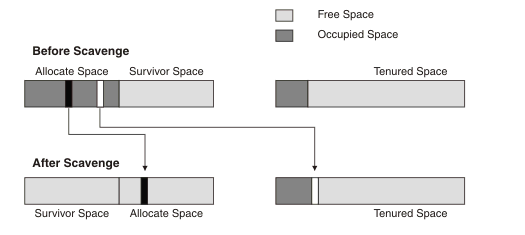IBM User Guide for Java V7 on Windows > IBM SDK for Java > The collector and the allocator
Generational Concurrent Garbage Collector
The Generational Concurrent Garbage Collector has been introduced in Javaâ„¢ 5.0 from IBM. A generational garbage collection strategy is well suited to an application that creates many short-lived objects, as is typical of many transactional applications.
You activate the Generational Concurrent Garbage Collector with the -Xgcpolicy:gencon command-line option.
The Java heap is split into two areas, a new (or nursery) area and an old (or tenured) area. Objects are created in the new area and, if they continue to be reachable for long enough, they are moved into the old area. Objects are moved when they have been reachable for enough garbage collections (known as the tenure age).

The new area is split into two logical spaces: allocate and survivor. Objects are allocated into the Allocate Space. When that space is filled, a garbage collection process called scavenge is triggered. During a scavenge, reachable objects are copied either into the Survivor Space or into the Tenured Space if they have reached the tenured age. Objects in the new area that are not reachable remain untouched. When all the reachable objects have been copied, the spaces in the new area switch roles. The new Survivor Space is now entirely empty of reachable objects and is available for the next scavenge.

This diagram illustrates what happens during a scavenge. When the Allocate Space is full, a garbage collection is triggered. Reachable objects are then traced and copied into the Survivor Space. Objects that have reached the tenure age (have already been copied inside the new area a number of times) are promoted into Tenured Space. As the name Generational Concurrent implies, the policy has a concurrent aspect to it. The Tenured Space is concurrently traced with a similar approach to the one used for –Xgcpolicy:optavgpause. With this approach, the pause time incurred from Tenured Space collections is reduced.
- Tenure age
Tenure age is a measure of the object age at which it should be promoted to the tenure area. This age is dynamically adjusted by the JVM and reaches a maximum value of 14. An object’s age is incremented on each scavenge. A tenure age of x means that an object is promoted to the tenure area after it has survived x flips between survivor and allocate space. The threshold is adaptive and adjusts the tenure age based on the percentage of space used in the new area. - Tilt ratio
The size of the allocate space in the new area is maximized by a technique called tilting. Tilting controls the relative sizes of the allocate and survivor spaces. Based on the amount of data that survives the scavenge, the ratio is adjusted to maximize the amount of time between scavenges. - Split heap
A split heap allocates the new and old areas of the generational Java heap in separate areas of memory. A split heap forces the Garbage Collector to use the gencon policy and disables resizing of the new and old memory areas. Use the -Xgc:splitheap command-line option to enable the split heap. This option is available on the Windows 32-bit JVM only.
Parent: The collector and the allocator
Error 404 - Not Found
The document you are looking for may have been removed or re-named. Please contact the web site owner for further assistance.